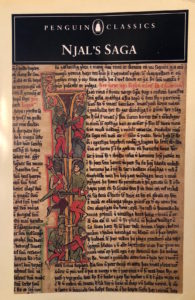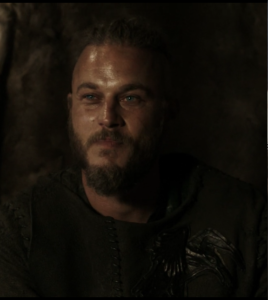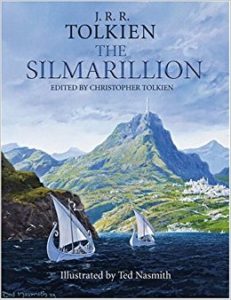By Stan Pelkey
In mid-January, during the last few days my two children were home for winter break, my son and I began to watch the first season of Vikings (Michael Hirst, 2013–2018) on Amazon Prime’s streaming video service. We’d watched The Last Kingdom on BBC America in 2015, and we’re huge fans of Game of Thrones, so Vikings seemed like a promising choice, given our preferences for epic storytelling on television.
Now this post is not a review of Vikings, which I do enjoy very much. I may post such a review later. Watching the program, however, motivated me to go back to my bookshelf of medieval European literature (yes, that’s a real thing in my office at home), which I collected while working on my MA in European History, and I began reading the great Icelandic prose text, Njal’s Saga.
 What began as an exercise in “how well did Hirst capture the sense of historical Viking society, culture, and attitudes?” (with some collateral “ah, there’s a bit of Tolkien!” thrown in) quickly morphed into an exploration of historical “mentalities” embedded in literature, a practice that was central to my training as a historian. And then my reading became the basis for this, my third blog post on literature and leadership.
What began as an exercise in “how well did Hirst capture the sense of historical Viking society, culture, and attitudes?” (with some collateral “ah, there’s a bit of Tolkien!” thrown in) quickly morphed into an exploration of historical “mentalities” embedded in literature, a practice that was central to my training as a historian. And then my reading became the basis for this, my third blog post on literature and leadership.
Njal’s Saga is long enough and dense enough and has a large enough cast of characters that I may mine its riches over several posts this year. (As a comparison, think of the size and narrative style of Tolkien’s The Silmarillion, rather than his The Hobbit.) What I wish to focus on first is the importance—for a leader or would-be leader—of surrounding oneself with people of good character, being willing to find common ground, and using compromise as a tool for crafting the common good.
The events of Njal’s Saga take place roughly a century after the events depicted in the first four seasons of Vikings (i.e., the late 900s rather than the 800s). The first half of the saga focuses on four significant, recurring figures: the half-brothers, Hoskuld and Hrut; and the friends Gunnar and Njal. In each of those pairings, the latter individual is a wise man with powerful spiritual gifts who serves as a trusted advisor to the former man. Hoskuld and Gunnar rise to levels of great wealth and power by exhibiting the character traits that the Saga consistently celebrates in men: strength of arms (whether one is a farmer, trader, or lawyer); shrewdness; a core even-temperedness; reliability and loyalty toward friends; and ruthlessness toward enemies. (I think one could argue that these are also the character traits of Ragnar in Vikings, at least during the first two seasons, and perhaps even more so of his eldest son, Bjorn.  Likewise, John Snow and Daenerys Targaryen from Game of Thrones also demonstrate those characteristics, and one might argue that the lack of shrewdness was precisely the reason that the Stark men played the game of thrones so poorly.)
Likewise, John Snow and Daenerys Targaryen from Game of Thrones also demonstrate those characteristics, and one might argue that the lack of shrewdness was precisely the reason that the Stark men played the game of thrones so poorly.)
Hrut likewise rises to prominence and rightfully gains his place of power and influence beside his half-brother after spending time trading and fighting abroad and demonstrating those same character traits just enumerated. He’s motivated to go abroad, in part, because he is told early in the Saga that while his brother is a famous leader, he is unknown. In this way, Hrut’s rise from beneath his brother’s shadow could have been a model for the long narrative arc in Vikings in which Rollo continuously wrestles with his place and reputation in relation to his more skillful and successful brother, Ragnar.
Early in Njal’s Saga, Hoskuld’s family and Gunnar’s family are nearly swept into violent conflict. Hrut, however, urges his brother to resolve their dispute with gifts and pledges of friendship rather than by single combat, which he knows Hoskuld will lose. Hrut’s wisdom in pursuing a face-saving compromise between the two families is rewarded richly when Gunnar falls in love with Hoskuld’s daughter, Hallgerd – now widowed twice and a landowner in her own right. Through the subsequent marriage of Hallgerd and Gunnar—which Gunnar would not have contemplated but for the willingness of Hoskuld to settle their earlier dispute peacefully— the two families become bound by both promises of friendship and by blood.
In contrast to the valiant Hoskuld and Gunnar and the wise Hrut and Njal, the saga continuously introduces a cast of minor, villainous, and often short-lived male characters regularly referred to as “scoundrels.” Unlike the valiant and wise leaders, these characters are led easily into trouble; lead others into misfortunate with poor and even malicious advice; lie, even to their allies; and mouth off.
As the first of these “scoundrels” are introduced, the saga moves into a peculiar phase in which Gunnar’s family and household are, for several years, pitted against the family and household of his friend Njal. The conflict begins with an underlying jealousy between Hallgerd (Gunnar’s wife) and Bergthora (Njal’s wife), and the two women use the scoundrels in their respective husbands’ households to needle each other. Over a series of chapters, there is a cycle of tit-for-tat murders between the two families, starting with household slaves, then moving up the social scale from freemen, to minor kinsmen, and finally to close and important kinsmen. With each cycle of violence, more fighters are forced to take part in the respective revenge killings (to ensure numerical advantages for the “winning” side), until the spiraling cycles of violence and vengeance threaten to suck both households into open warfare.
With each cycle of violence, Njal and Gunnar also agree to pay appropriate compensation to each other (in keeping with Viking law) in order contain the threat of open warfare and to maintain their personal friendship. They make these decisions despite the bitterness of their wives and the seething anger of their respective collections of hot-tempered sons. Again, the leadership displayed by Njal and Gunnar is embodied first and foremost in a willingness to find an appropriate compromise that is consistent with their “institutional” policies / procedures / safeguards rather than allowing disagreements between their cliques or camps to spiral out of control – which would only benefit their mutual enemies. Real leaders are often tasked with holding the line for peace in the face of opposition from even one’s closest friends and relatives. By maintaining the common ground despite opposition within their own camps, Njal and Gunnar hold their alliance together, and after the cycles of violence subside, the two families find genuine peace and are ready to work together again to mutually protect each other from both the ravages of famine and the threats of far worse regional opponents.
This leads me to my second observation: leaders must be sure to have a close circle of confidents and advisors who are of good character themselves. Hoskuld and Gunnar have that in their primary advisors – Hrut and Njal – and Gunnar also has a brother, Kolskegg, who is valiant and trustworthy. But why are there so many men of poor character in their households? One has to assume that some of this is simply a function of the need for a certain level of man power to run their farms, manage their flocks, and look after their logging and fishing enterprises. (Of course, their presence also serves a fundamental literary function, driving the plot forward.) But it is clear from the narrative that Hoskuld, Gunnar, and Njal do not seek the advice of such men. Contrarily, their chief enemies, who are not men of noble character, do turn to the unscrupulous characters in their households for advice – which leads to terrible consequences.
Gunnar for his part goes further: his is not simply a passive avoidance of the advice of the “scoundrels” in his inner circle; Gunnar also actively urges those men to stay out of trouble and to avoid being led astray by the scheming of the jealous Hallgerd. Nevertheless, neither Gunnar nor Njal resort to micromanaging the behavior of every single person in their households. This would be impossible to do and is not the best use of any leader’s time or energy. Thus, if they cannot avoid all problems caused by the actions and decisions of the people who work for them, they are at least ready to contain the impact of the potential crises caused by those other men. That being said, even good leaders reach limits with the scoundrels in their midst, as when Hrut finally kills in single combat one scoundrel, Thjostolf, who keeps getting his niece Hallgerd into trouble with her first two husbands.
Now I’m certainly not advocating that we settle modern leadership / organizational problems by turning to violence. Far from it. But in reading this literature as a study in human ideas and behavior and of leadership ideals and ethical systems, some of which appear to have remained remarkably stable for the past millennium, we can distill several timeless prescriptions: Good leaders will minimize risks to their organization to begin with by developing cadres of folks of good character— and note, these are not simply those one most enjoys or gets along with best—who serve as primary advisors and agents. Furthermore, when conflict emerges, whether within the organization or between one’s organization and another, a good leader will seek and hold the common ground for the common good for as long as possible (which will likely be longer than most people want). But finally, a good leader must be willing to be decisive when circumstances call for it and to act to protect others in the organization from the malicious influence of “scoundrels”. The alternative is becoming trapped in a spiraling cycle of internal and external conflict and recriminations that can derail the mission of the organization and ultimately tear it apart.

